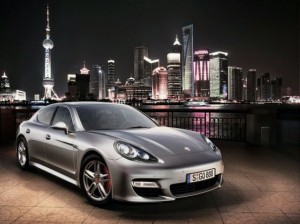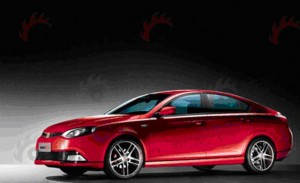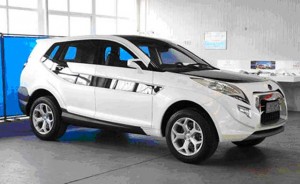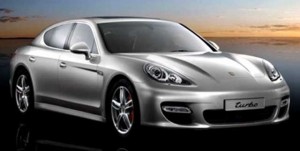
The unveiling of the production version of the long-awaited Porsche Panamera highlights the 2009 Shanghai Motor Show, though at least a dozen other local and foreign products will make their global debut, as well.
They say the global recession has finally hit China, but you’d be hard pressed to tell by the frenetic pace of Shanghai, host of this year’s Chinese motor show – and the backdrop for a flood of new vehicles, including the production version of the Porsche Panamera 4-door sports car.
Once little more than a regional outpost for marginal native nameplates. The Shanghai Motor Show – which alternates every other year with Beijing – has become one of the most important events in the automotive world. And it could become even more significant in the years to come, considering that as of January, China is on pace to surpass the U.S. as the world’s largest automotive market.
The Shanghai and Beijing shows, meanwhile, could soon eclipse the faltering Tokyo Motor Show, which organizers nearly cancelled for 2009 due to weak foreign participation. With the Japanese market all but closed to imports, manufacturers would rather focus their recession-restricted budgets on markets where they might actually sell their products. And China certainly qualifies.
In recent years, the Chinese government has steadily rolled back restrictions on the industry, and has taken numerous steps, at both the national and local level, to prop up automotive demand during the recession. Beijing has, for example, enacted new tax cuts on fuel-efficient vehicles. It’s also taking steps to boost sales in more poorer, more rural regions of the country. All told, the various moves helped push demand, in March, to 1.1 million vehicles. That was a 5 percent increase – and marked the third month in a row that sales exceeded those in the economically-depressed U.S.
 The Shanghai Motor Show will play a critical role in building demand even further. Close to 100 different manufacturers will display at the city’s sprawling convention facility, including scores of local marques, such as Roewe and Great Wall. In recent years, Beijing has quietly been encouraging a shake-out among Chinese local makers, forcing the weaker among them to sell out or close all together.
The Shanghai Motor Show will play a critical role in building demand even further. Close to 100 different manufacturers will display at the city’s sprawling convention facility, including scores of local marques, such as Roewe and Great Wall. In recent years, Beijing has quietly been encouraging a shake-out among Chinese local makers, forcing the weaker among them to sell out or close all together.

Chinese makers are showing a number of new products, this year, including Roewe's new MG6.
Others, such as Roewe, BYD, SAIC and Briliiance, are being groomed for greater things – often with the political and financial support of regional governments. Some of them have grown fat and happy through partnerships with Western or Japanese manufacturers – Chinese laws require foreign makers to partner with Chinese car companies when setting up assembly lines in the country. SAIC, for example, is tied to both General Motors and Volkswagen. But the steady profits have encouraged the Shanghai-based firm to expand operations under its own nameplate.
Among the more eagerly awaited local previews are the debut of the MG6, from Roewe, and the Great Wall Hover H7.
The former maker acquired most of the assets of the failed British Rover, earlier in the decade, and has been relying on traditionally English designs, at least until now, with models like its Roewe 550 and 750. But the MG6 is a bit more of what might be called “international” in appearance, with the sort of coupe-like roofline that has been sweeping through the automotive design world.
Chinese makers – like the South Koreans and Japanese before them – have taken hits for their lack of a distinctive national styling theme. That’s not surprising, considering the industry’s heavy dependence upon foreign partners for engineering and design work. But that’s slowly beginning to shift. Ironically, some of the most striking new shapes to come out of China, in recent years, have emerged from the well-funded GM design center, PATEC, in Shanghai. The Buick Park Avenue concept, of two years ago, will be reappearing in production form, both in China, and in the U.S., where a modified version will be sold as the next-generation LaCrosse.

Just do it: the Nike "swoosh" on the Hover H7 suggests that while Chinese makers are trying to develop distinctive styling, they aren't always getting it right.
Even independent Chinese makers are stretching their capabilities, as this year’s Shanghai show will demonstrate – but not always to great success. The nose of the Great Wall Hover H7, for example, looks like the intake for an oversized vacuum cleaner, while a series of transparent panels, etched like a giant Nike “swoosh,” extends from the rear fender all the way to the front wheel well.
But while domestic Chinese makers are demanding more attention, the real stars are still the European, American and Japanese makers that are helping shine the global spotlight on the 2009 Shanghai Motor Show.
One of the most significant events, this year, came right after the show opened to the global media: Rolls-Royce announced that it will be calling its new “small” luxury sedan the Ghost. Until now it had been known, alternately, as the RR4 and 200EX concept vehicle.
Perhaps the biggest news of the show could come from Porsche, however, which has finally revealed the production version of its controversial four-door sports car, the Panamera. Significantly, this marks the first time the German maker has debuted an all-new model outside Europe or the U.S.

The Shanghai debut of the Porsche Panamera marks the first time the German maker has debuted an all-new product outside of the U.S. or Europe.
Not to be outdone, Mercedes-Benz also used the Shanghai show for the backdrop of a world debut, in this case its updated S65 AMG. While the biggest growth has come at the mid and lower ends of the Chinese market, there’s still a surge in demand among high-line buyers and, notably, sales of Mercedes’ high-performance arm, AMG, surged nearly 300 percent last year. Government incentives are expected to keep demand growing in 2009.
This year’s Shanghai show should also highlight the growing interest in green machines. The government has played a particularly heavy-handed roll in encouraging the industry to switch to electric power, with models such as the e301. That’s a battery-powered crossover concept that will be revealed by the domestic maker, Chang’An.
Shanghai, Beijing and the other cities along the populous and comparatively rich eastern crescent are blackened by pollution, and communist party leaders would like to mandate a switch to cleaner power as soon as possible. There’s a substantial production base for advanced lithium-ion batteries in China, which could encourage the transition – and give domestic makers an outlet for their global aspirations.
BYD, in fact, put the world’s first production plug-in hybrid on sale late last year, nearly two years ahead of when General Motors hopes to launch its Chevrolet Volt plug-in. Short for Bring Your Dreams, the company – which produces much of the world’s laptop computer and cellphone batteries – hopes to take a version of its plug-in hybrid to the U.S. by earlier in the next decade.
